Rio de Janeiro, Brazil
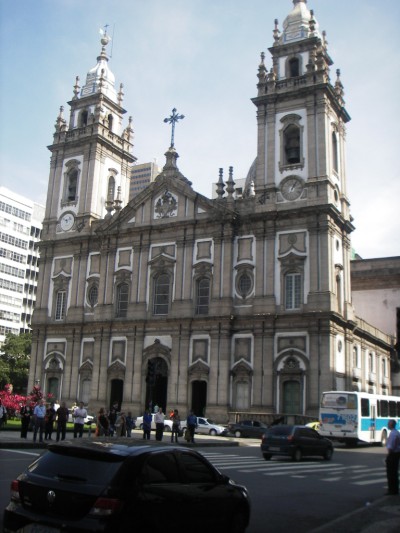
Monthly Archives: July 2009
Rio de Janeiro
Rio de Janeiro, Brazil
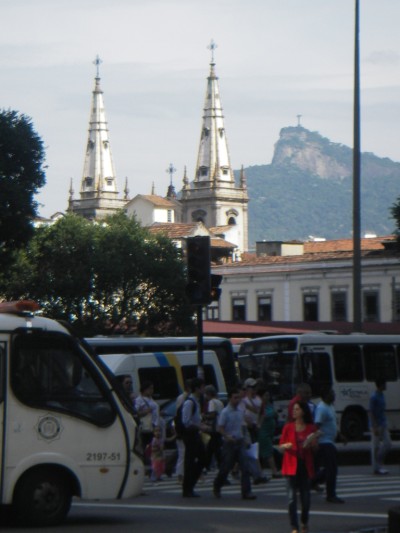 Downtown Rio de Janeiro.
Downtown Rio de Janeiro.
Submarine in Rio
Rio de Janeiro, Brazil
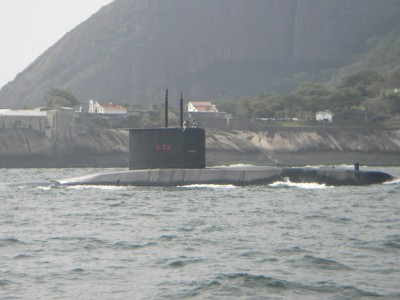 While entering Rio de Janeiro’s harbor, this submarine passed in front of the old fort at the entrance.
While entering Rio de Janeiro’s harbor, this submarine passed in front of the old fort at the entrance.
Cabo Frio
near Cabo Frio, Brazil
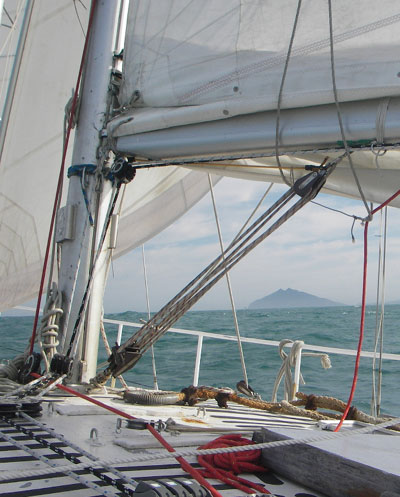 Cabo Frio, which is pretty much the East corner of Brazil (East of Rio de Janeiro), is the peak seen under the mainsail of Issuma. Cabo Frio (Cold Cape in English) is a place where a lot of deep, cold water is forced to the surface by the action of the currents against the coast. This results in pushing up a lot of plankton and other animals from the deep, which whales and many fish feed on.
Cabo Frio, which is pretty much the East corner of Brazil (East of Rio de Janeiro), is the peak seen under the mainsail of Issuma. Cabo Frio (Cold Cape in English) is a place where a lot of deep, cold water is forced to the surface by the action of the currents against the coast. This results in pushing up a lot of plankton and other animals from the deep, which whales and many fish feed on.
New Winch
near Cabo de Sao Tome, Brazil
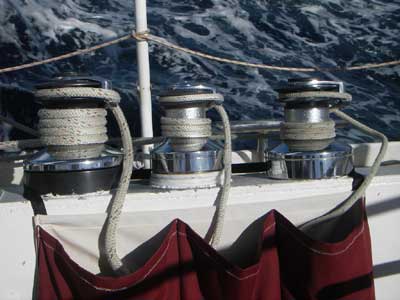 Sailboats generally have one winch for each sheet (a rope that controls a sail once it is up). There were not enough winches on this boat to have one for each sheet. So, when setting the main staysail (voile d’etai), the sheet had to be brought across the cockpit and put on the (windward side) fore staysail (trinquette) sheet winch. While that worked, it meant there was this taut rope across the cockpit, somewhat getting in the way.I bought a new pair of sheet winches some time ago, and finally got around to installing one of them last week (I wanted to sail with it for a while to be sure I liked the position before installing the other one on the other side). The winch on the left is a Lewmar 55, the one of the right is a Lewmar 48, and the new one in the center is also a Lewmar 48. I was quite surprised when the new winches arrived to find out that the new Lewmar 48s are significantly smaller than the old Lewmar 48s. So I got some long bolts and built up the base with some white plastic so it would be high enough for the winch handle to clear the top of the other winches.A sailmaker in Itaparica built the sheet bags that hang below the winches. They help to tidy up the cockpit a great deal.
Sailboats generally have one winch for each sheet (a rope that controls a sail once it is up). There were not enough winches on this boat to have one for each sheet. So, when setting the main staysail (voile d’etai), the sheet had to be brought across the cockpit and put on the (windward side) fore staysail (trinquette) sheet winch. While that worked, it meant there was this taut rope across the cockpit, somewhat getting in the way.I bought a new pair of sheet winches some time ago, and finally got around to installing one of them last week (I wanted to sail with it for a while to be sure I liked the position before installing the other one on the other side). The winch on the left is a Lewmar 55, the one of the right is a Lewmar 48, and the new one in the center is also a Lewmar 48. I was quite surprised when the new winches arrived to find out that the new Lewmar 48s are significantly smaller than the old Lewmar 48s. So I got some long bolts and built up the base with some white plastic so it would be high enough for the winch handle to clear the top of the other winches.A sailmaker in Itaparica built the sheet bags that hang below the winches. They help to tidy up the cockpit a great deal.
Whales
Brazil
 Sailing on the banks in the rain yesterday, many whales were nearby, making it much more interesting to be outside.
Sailing on the banks in the rain yesterday, many whales were nearby, making it much more interesting to be outside.
Bahian sailboat
Bahia, Brazil
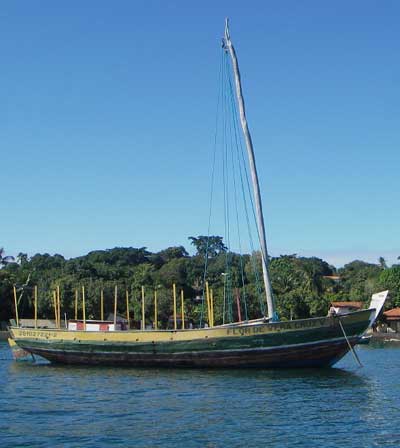 A similar boat to the one sailing in yesterday’s picture. Note the mast that was made by simply taking the bark off a tree. I never found the crew of this boat to ask what the vertical stakes are for…I suspect they are used to dry fishing nets.
A similar boat to the one sailing in yesterday’s picture. Note the mast that was made by simply taking the bark off a tree. I never found the crew of this boat to ask what the vertical stakes are for…I suspect they are used to dry fishing nets.
Bahian sailboat
Bahia, Brazil
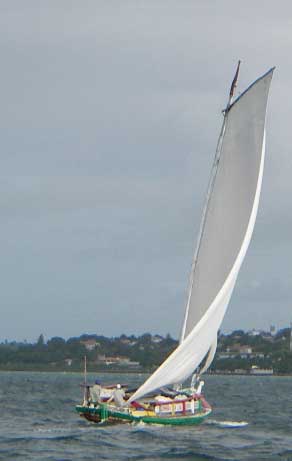 Traditional Bahian sailboat beating to windward. I took this picture a few days ago in Bahia de Todos Santos. The died to nothing yesterday, then came back to a nice force 3 tailwind, with clear skies, lots of stars and a fair-sized moon. Now (morning) the wind is dying away again and the sails are making lots of noise as they flop around with the gentle rolling of the boat.
Traditional Bahian sailboat beating to windward. I took this picture a few days ago in Bahia de Todos Santos. The died to nothing yesterday, then came back to a nice force 3 tailwind, with clear skies, lots of stars and a fair-sized moon. Now (morning) the wind is dying away again and the sails are making lots of noise as they flop around with the gentle rolling of the boat.
Rainbow leaving Salvador
Salvador, Bahia, Brazil
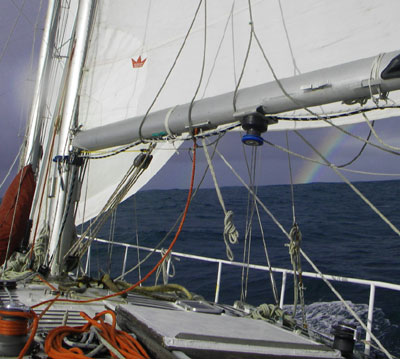 A nice rainbow appeared while leaving Salvador today. The weather was off and on, rain and sun all morning, gradually becoming drier, mostly sunny, and less windy. By night, the waves were much smaller, and the stars and Milky Way poked their way out among the scattered clouds making for a very pleasant sail. I am sailing south, out of the tropics, towards cooler weather.
A nice rainbow appeared while leaving Salvador today. The weather was off and on, rain and sun all morning, gradually becoming drier, mostly sunny, and less windy. By night, the waves were much smaller, and the stars and Milky Way poked their way out among the scattered clouds making for a very pleasant sail. I am sailing south, out of the tropics, towards cooler weather.
Heraclitus
Itaparica, Bahia, Brasil
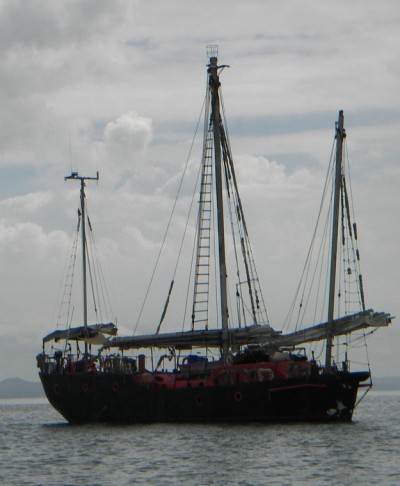 The most uncommon-looking boat at anchor in Itaparica when I arrived was the Research Vessel Heraclitus. Heraclitus was built of ferrocement in California in 1974 and has sailed around the world several times, 250,000 miles in all. I’ve long been interested in junk-rigged vessels, and this is the largest (85 feet/26m, 120 tons) and most-sailed junk that I’ve seen. A friendly crewman from the Solomon Islands showed me around the boat, which, among other things, is equipped with a library of hundreds of books and a large laboratory area. Heraclitus does mostly environmental reseach for various organizations. More information on their website at http://www.rvheraclitus.org
The most uncommon-looking boat at anchor in Itaparica when I arrived was the Research Vessel Heraclitus. Heraclitus was built of ferrocement in California in 1974 and has sailed around the world several times, 250,000 miles in all. I’ve long been interested in junk-rigged vessels, and this is the largest (85 feet/26m, 120 tons) and most-sailed junk that I’ve seen. A friendly crewman from the Solomon Islands showed me around the boat, which, among other things, is equipped with a library of hundreds of books and a large laboratory area. Heraclitus does mostly environmental reseach for various organizations. More information on their website at http://www.rvheraclitus.org